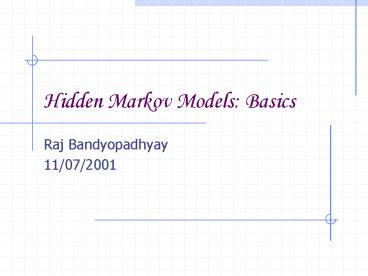Hidden Markov Models: Basics - PowerPoint PPT Presentation
1 / 20
Title:
Hidden Markov Models: Basics
Description:
A flips first, followed by B, then A again. Representation as state ... The persons flipping the coin are hidden? Only the results of the coin flips known? ... – PowerPoint PPT presentation
Number of Views:44
Avg rating:3.0/5.0
Title: Hidden Markov Models: Basics
1
Hidden Markov Models Basics
- Raj Bandyopadhyay
- 11/07/2001
2
Our running example
- Hypothetical Nucleic Acid (HNA)
- Two bases or residues H and T
- Assume existence of HNA databases
- Examples
- HTTTHT
3
Motivating Example
- HNA sequence database HTT, TTT, HHH, TTH
- 1 2 3
- H T T
- T T T
- H H H
- T T H
- P(H)P(T)0.5 P(H)0.25 P(H)P(T)0.5
- P(T)0.75
- Positions 1 3 are determined by an unbiased
coin, whereas position 2 is determined by a
biased coin.
4
Motivating Example (contd.)
- Imagine 2 people A and B
- A holds an unbiased coin P(H)P(T)0.5
- B holds a biased coin P(T)0.75, P(H)0.25
- Our HNA database can be explained
- A flips first, followed by B, then A again
- Representation as state diagram (Markov Chain).
5
Markov Representation
6
Hidden Markov Model
- What if
- The persons flipping the coin are hidden?
- Only the results of the coin flips known?
- I.e. Only emissions known states unknown
- Hidden Markov Model
- What can we infer
- From a given HMM about the data?
- From given data about the generating HMM?
7
Terms to understand
- State
- Transition Transition probability
- Emission Emission Probability
- Path
t110.5
t220.5
End
e2H0.25 e2T0.75
e1H0.5 e1T0.5
Start
t1E0.5
t120.5
tS11
8
Questions of interest
- For a given HMM
- Probability of generating a particular output
sequence? Likelihood - Most probable path? Decoding
- Adjusting probabilities in the light of observed
sequences? Learning/training
9
Likelihood
- Baum-Welch score Likelihood of a sequence s
Sum of likelihoods of all paths generating s - -log Lo(M) -ve log likelihood used in practice
- Two kinds of deductions required
- Forward Given observations upto time t, to
predict sequence state at time t1 - Backward Given observations from time t1, to
deduce sequence state at time t.
10
Calculating Likelihood
- The forward recursive relation
- Dynamic Programming Store previously calculated
values of at(i) Forward method - Similarly, the backward recursive relation leads
to the Backward method
11
Example
0.4
0.6
1
End
P(H)0.2 P(T)0.8
P(H)0.3 P(T)0.7
Start
1
1
2
Consider the sequence sHT. Paths generating
s 11, 13 LHT(M) 10.20.40.8
(10.20.6)0.7 a1(1)1 a2(1)10.20.4 a2(2)10.
20.6
12
Most Probable Path
- Viterbi Score of HMM M w.r.t sequence O
- Most probable path to generate O
- Recursive method and dynamic programming
Viterbi Algorithm - Let pi(t) path ending in state i at time t
13
Learning Training HMMs
- Assume we have seen part X of a complete
sequence Y. - So far, we have a model M to maximize LX(M)
likelihood of X given M - We want a new model M to maximize LY(M), given
X and M - This is the Baum-Welch (EM) algorithm
14
Expectation-Maximization
- Expectation Step obtain a score for the
goodness of a new model - Maximization Step set the new model as that
with maximum goodness
15
New Baum-Welch HMM parameters
- New transition probabilities
- New emission probabilities
16
Gradient Descent
- Gradient Descent (Baldi-Chauvin)
- Define log-likelihood as an energy measure
- Derive new model parameters so to minimize this
energy at every step - Iterative greedy algorithm
- Advantages over Baum-Welch
- Online updates
- Absorbing 0-probability in Baum-Welch
17
A Real Sequence HMM
Matching (main), insert and delete states
18
Implementation issues
- Parameter initialization average,
- uniform, random etc.
- Priors initialized to favor transitions towards
matching (main) states - Initialization from existing Multiple Alignments
- Model length Average length of input sequences
- Adaptable architecture?????
19
HMMs Advantages
- Solid statistical foundation
- Efficient learning algorithms
- Flexible and general model for sequence
properties - Unsupervised learning from variable-length, raw
sequences
20
HMMs Disadvantages
- Large number of unstructured parameters
(emission and transition parameters) - Need large amounts of data
- Subtle long-range correlations in real sequences
unaccounted for, due to Markov property































